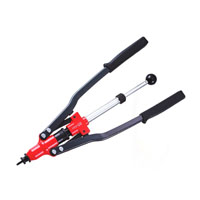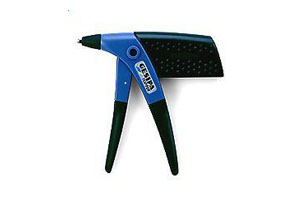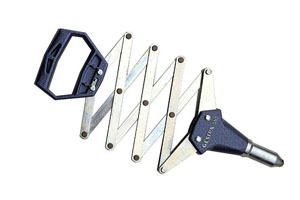 Blind rivet riveter has been widely used in construction due to the simplicity, reliability and high speed of fastening various sheet materials with blind rivets. Riveters of this type come in various types: pneumatic, electric and manual. In this article, we will talk specifically about the varieties of hand riveters. We note right away that in private construction they are most common due to their low price.
Blind rivet riveter has been widely used in construction due to the simplicity, reliability and high speed of fastening various sheet materials with blind rivets. Riveters of this type come in various types: pneumatic, electric and manual. In this article, we will talk specifically about the varieties of hand riveters. We note right away that in private construction they are most common due to their low price.
The principle of operation of a hand riveter is quite simple. A rivet is inserted into the previously prepared hole, the tail (punch) of which is inserted into the tip of the tool. After that, with the help of movements of the handles, the tail is pulled out of the rivet and it is securely fixed. As a result of excess stress, the punch breaks and the excess part remains in the riveter, and only the connection remains on the material, which practically does not protrude beyond the surface.
Types of hand riveters
1. Manual riveter in the form of a beech "G"
This riveter is very convenient to use when fastening in corners and complex profiles. With it, you can crawl and fasten rivets where a straight riveter will not work.

2. Straight hand riveter
This riveter is also called two-handed. You can recognize it by its characteristic appearance. In shape, its handles are of the same length and form an acute angle. With this manual riveter, it is convenient to fasten rivets on flat surfaces. Thanks to the large length of the handles, with little effort, you can create a significant amount of leverage and easily install the rivet. For large diameter blind rivets, this is the best option.

3. Mini hand riveter
This riveter is usually a smaller copy of the "G" shaped riveter. Its main advantage is that they can install rivets with one hand. True, they are usually designed for a small size of rivets, which affects the strength of the connection and the thickness of the materials being fixed.

4. Lever hand riveter
To be completely honest, this is a modified version of the direct riveter. Only the force supply system for pulling the rivet has been changed. With a straight riveter, this is done by spreading the handles, and in this embodiment, you push the handle towards the fastener and the lever system acts on the head and pulls out the tail of the rivet. The design is more convenient if fastening in narrow places is necessary, but less reliable, since over time the lever system becomes loose and may break.

Features of the selection and operation of manual riveters
When choosing a riveter model, it is desirable to take into account the working conditions. If it is necessary to perform fasteners at a height above chest level, then the hands get quite tired from a powerful and, accordingly, heavy tool, but at the same time, the installation of the rivet occurs with less effort, because. such a riveter has more leverage. The small riveter model can be operated with one hand, while it is convenient to fix the material, for example, under the roof eaves or in conditions where there is a need to hold the ladder with one hand.
During operation, the riveter can change interchangeable tips used for different diameters of blind rivets. If the chosen tool has such an opportunity, then this is a big plus. The diameter of the drawing rod (punch) corresponds to the diameter of the hole in the tip. If the hole diameter is larger than the punch diameter, then when the rivet is installed, some of the soft metal of the rivet may remain inside the tip, making it difficult to use the next rivet.
If the riveter is designed for a maximum rivet diameter of 5.5 mm, then the optimal operating mode of the riveter for its long service life will be with rivets of no more than the penultimate diameter, i.e. 4.8 mm, due to the development of working elements (sponges). Also, the “life” of the riveter is significantly extended by its smooth operation during the installation of the rivet, and, on the contrary, jerks, the extraction of the punch not at a right angle to the plane of the material to be fixed, significantly wear out the riveter, and leads to its breakage.
The development of the working elements of the tool leads to poor fixation of the rivet in it, in the process of preparing the riveter for use. This disadvantage is temporarily eliminated by washing the working part with a small amount of solvent or solvent.
Other hand tools
|
Useful articles |